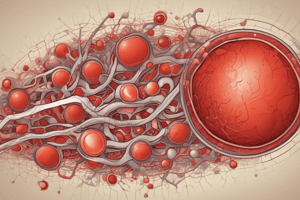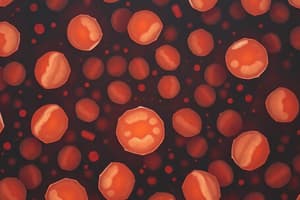Podcast
Questions and Answers
A patient presents with fatigue, pallor, and shortness of breath. Based on the provided definitions alone, what condition is primarily indicated?
A patient presents with fatigue, pallor, and shortness of breath. Based on the provided definitions alone, what condition is primarily indicated?
- Erythrocytopenia (correct)
- Leukemoid Reaction
- Leukemia
- Thrombocytopenia
Which of the following is NOT a typical manifestation associated with thrombocyte dysfunction?
Which of the following is NOT a typical manifestation associated with thrombocyte dysfunction?
- Epistaxis
- Spontaneous gingival bleeding
- Petechial hemorrhages
- Oral candidiasis (correct)
A patient exhibits oral ulcerations with a pale, grayish-white necrotic base, along with frequent viral infections. Which cellular issue is MOST likely underlying these findings?
A patient exhibits oral ulcerations with a pale, grayish-white necrotic base, along with frequent viral infections. Which cellular issue is MOST likely underlying these findings?
- Erythrocyte deficiency
- Leukocyte abnormality (correct)
- Thrombocyte excess
- Leukemoid reaction
In the context of leukemia, the presence of poorly differentiated leukemic cells in which locations is typically required for a diagnosis?
In the context of leukemia, the presence of poorly differentiated leukemic cells in which locations is typically required for a diagnosis?
In which specific condition are leukemic cells exclusively found in the bone marrow and not typically in peripheral blood?
In which specific condition are leukemic cells exclusively found in the bone marrow and not typically in peripheral blood?
A patient presents with a white blood cell count of 15,000/mL. Which of the following conditions is most likely?
A patient presents with a white blood cell count of 15,000/mL. Which of the following conditions is most likely?
Which of the following is NOT typically a cause of leukocytosis?
Which of the following is NOT typically a cause of leukocytosis?
A patient's differential white blood cell count shows 15% lymphocytes, 65% neutrophils, 5% monocytes, 2% eosinophils, and 1% basophils could be indicative of:
A patient's differential white blood cell count shows 15% lymphocytes, 65% neutrophils, 5% monocytes, 2% eosinophils, and 1% basophils could be indicative of:
Which of the following best describes the relationship between pancytopenia and leukopenia?
Which of the following best describes the relationship between pancytopenia and leukopenia?
A patient's blood test shows a WBC count of 3,000/mL, along with a differential count showing markedly reduced levels of neutrophils and monocytes. Which of the following conditions can best explain this result?
A patient's blood test shows a WBC count of 3,000/mL, along with a differential count showing markedly reduced levels of neutrophils and monocytes. Which of the following conditions can best explain this result?
Which characteristic is LEAST associated with Chronic Lymphocytic Leukemia (CLL)?
Which characteristic is LEAST associated with Chronic Lymphocytic Leukemia (CLL)?
A patient presents with a hallmark Philadelphia chromosome. Which condition is most likely the underlying cause?
A patient presents with a hallmark Philadelphia chromosome. Which condition is most likely the underlying cause?
What is a common systemic effect of Chronic Myelogenous Leukemia (CML) that also presents as a result of normal cell deficiencies?
What is a common systemic effect of Chronic Myelogenous Leukemia (CML) that also presents as a result of normal cell deficiencies?
During the progression of Chronic Myelogenous Leukemia (CML), what describes the shift in characteristics of the leukemic cells entering the blast crisis phase?
During the progression of Chronic Myelogenous Leukemia (CML), what describes the shift in characteristics of the leukemic cells entering the blast crisis phase?
Which of the following clinical presentations is LEAST likely to be associated with leukemic cell infiltration in CML?
Which of the following clinical presentations is LEAST likely to be associated with leukemic cell infiltration in CML?
Flashcards
Leukocytosis
Leukocytosis
An increase in the number of white blood cells (WBCs) circulating in the blood.
Leukopenia
Leukopenia
A decrease in the number of white blood cells (WBCs) circulating in the blood.
Agranulocytosis
Agranulocytosis
A severe reduction in the number of neutrophils, a type of white blood cell.
Pancytopenia
Pancytopenia
Signup and view all the flashcards
Normal Differential WBC Count
Normal Differential WBC Count
Signup and view all the flashcards
What is Leukemia?
What is Leukemia?
Signup and view all the flashcards
What is Acute Leukemia?
What is Acute Leukemia?
Signup and view all the flashcards
What is Chronic Leukemia?
What is Chronic Leukemia?
Signup and view all the flashcards
What is AML?
What is AML?
Signup and view all the flashcards
What is ALL?
What is ALL?
Signup and view all the flashcards
Leukemia
Leukemia
Signup and view all the flashcards
Leukemoid Reaction
Leukemoid Reaction
Signup and view all the flashcards
Acute Lymphoblastic Leukemia (ALL)
Acute Lymphoblastic Leukemia (ALL)
Signup and view all the flashcards
Erythrocyte Deficiency
Erythrocyte Deficiency
Signup and view all the flashcards
Thrombocyte Deficiency
Thrombocyte Deficiency
Signup and view all the flashcards
What is Chronic Lymphocytic Leukemia (CLL)?
What is Chronic Lymphocytic Leukemia (CLL)?
Signup and view all the flashcards
What is Chronic Myelogenous Leukemia (CML)?
What is Chronic Myelogenous Leukemia (CML)?
Signup and view all the flashcards
What is the Philadelphia chromosome?
What is the Philadelphia chromosome?
Signup and view all the flashcards
What is blast crisis in CML?
What is blast crisis in CML?
Signup and view all the flashcards
What is the chronic phase of CML?
What is the chronic phase of CML?
Signup and view all the flashcards




